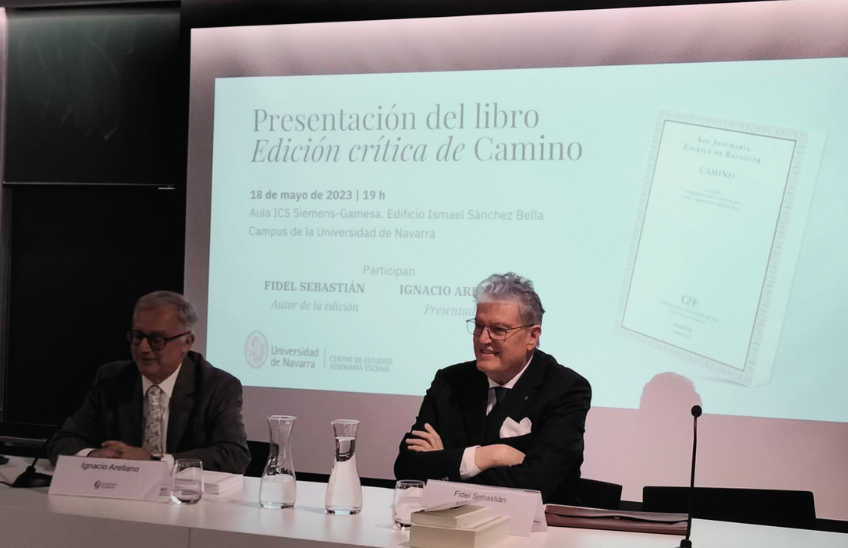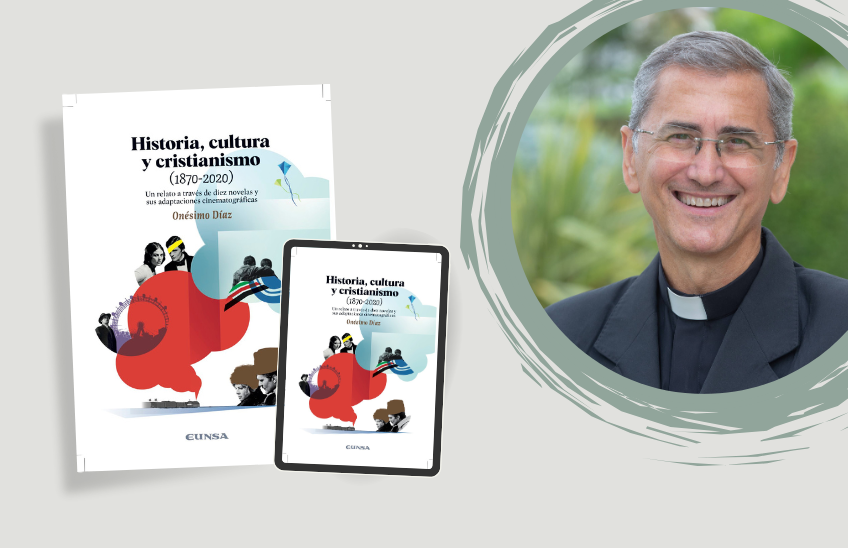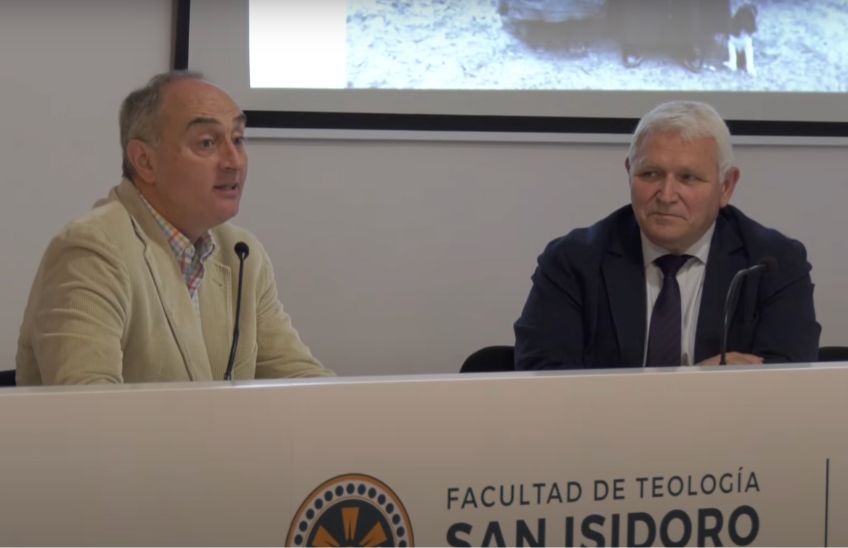Between past and present: new critical edition of 'Camino'.
The philologist Fidel Sebastián has published a critical edition of The Way, which offers a new vision of the book written by the founder of Opus Dei. In this interview, the author explains work , the relevance of The Way today, and the parallels between St. Josemaría and some of the Church's mystics.

29 | 05 | 2023
On May 18, the 'Critical edition of Camino' was presented at the University of Navarra by Fidel Sebastián, PhD in Hispanic Philology by the Autonomous University of Barcelona and researcher of the Spanish Golden Age.
The event was organized by the Center of programs of study Josemaría Escrivá and counted with the participation of Ignacio Arellano, Full Professor of Philology of the University of Navarra, and Fidel Sebastián, author of the critical edition of The Way.
After the presentation, CEJE interviewed the author who explained his research, the motivations of project and the impact of 'Camino' from its publication in 1939 to the present day.
Why did you decide to make a critical edition of the book 'Camino'?
In mid-2011, the Real Academia Española had commissioned me to edit the Libro de la vida de santa Teresa de Jesús for its collection Library Services Clásica. During those years of work on this text (2012-2014), while I moved forward highlighting, with the necessary notes, all the beauty and truth that enclosed those words, I dreamed of being able to do the same someday with 'Camino'. At the moment it did not seem feasible: among other things, copyright was still in force.
Later, I learned that requests to translate the book into a more "current" language were reaching those who administer these rights. I was asked for my opinion on the matter. My criterion in such situations has always been to preserve the author's language and enhance its value precisely by means of as exhaustive annotation as necessary, so that, after reading the notes, the reader returns to the text and enjoys savoring the peculiar way in which it is expressed: it is not only what he says that matters, but also, if not more, how he says it. This is as true of St. Teresa as it is of St. Josemaría.
After having published in successive years other critical editions of authors of the Golden Age, one of the people who are working on the preparation of the first centenary of Opus Dei, which will be in 2028, thought of proposing my idea to the foundation that administers the copyright of 'The Way', and we reached an agreement agreement. From that moment on I started working hard and without interruption until the book came out at the beginning of this year.
To what extent does this new edition financial aid give the reader a deeper understanding of 'Camino'?
I can not avoid the parallels with St. Teresa. In the book that the saint wrote, out of obedience, about her life - better, about the graces received from God throughout her life - she tried to preserve anonymity by all means. This included speaking about herself sometimes in the third person, avoiding names of persons or places by which she could be identified, etc. All this out of humility: if she had been told to write about her sins, she would have been happy to do so.
In the case of St. Josemaría, a young priest in his early thirties, with an interior life in which there was no lack of extraordinary manifestations of God's grace, the author speaks of what he knows from experience staff and pastoral experience: in order to serve the reader, he depersonalizes what is his own and attributes it to an impersonal or generic subject; what is not his own, if prudence demands it, he also veils it with modesty or silence.
After more than eighty years in which 'The Way' was written with the immediate readership of a group of young people who received directly from the author the training and spiritual direction, now the reader of the 21st century needs the financial aid of a profuse annotation that gives shape and color to the environment, the historical, religious and cultural context of those years that precede the 1939 in which it was published for the first time.
The regular reader of 'The Way' will now find explanations to questions he or she had wondered about, or will perceive details he or she had not noticed before, extracting from his or her reading new teachings or motivations and a more complete knowledge of the message of 'The Way' and of the author's radical and attractive holiness.

Ignacio Arellano and Fidel Sebastián during the presentation of the book at the UNAV.
Recently the high school Cervantes pointed out that 'Camino' is the fourth most translated work from Spanish into other languages, why do you think the book was received in different cultures?
The author boasted of possessing and spreading ecumenism among Christians long before the Second Vatican Council promoted it. St. Josemaría wrote in The Way for all Christians and for all people seeking the truth and the good. The author himself once declared that, with regard to the presentation of The Way, he wanted to break with the Spanish tradition of presenting pious books with black covers, and he asked those who helped him to do so in new ways, so that it would reach all places.
His training was not only priestly, but also academic and humanistic, and the ideal of transforming the world by infusing it with the spirit of Christ, led him not to forget any human creature and call to all, also with the help of the reader ("Would you not gladly shout out to the youth that swarm around you"...) to a task that no one should disdain ("leave that and come with us after Love").
More than 80 years have passed since the first edition of 'The Way', why do you think its message is still relevant today?
Precisely because his message is the Gospel. According to the author's expression, the message that God had entrusted him to transmit was as old as the Gospel, and, like the Gospel, new.
With the details provided in the notes of our edition, which often refer to the intimate notes that the author was taking about the events of his inner life and his pastoral work, the reader can discover the deepest motivations of the writer-saint. A mystic on a par with the greats, in whose life are manifested (and in 'The Way') throws of divine love like St. Teresa, such as "getting into the wounds of Christ"; heroism like St. John of the Cross in the withdrawal of all his things - even his most intimate affections - in the hands of God; or a gift of tongues like Fray Luis of Granada, capable of moving souls.
After a thorough study of the book, is there any section or specific point that has been of special interest to you? why?
Insisting, the radical nature of the author's sanctity, hidden in the book with the means that language lends to it, and that criticism is capable of unveiling by studying the sources and the environment in which it is written, has produced an inner stirring in me.
I fervently hope that in the future there will be a serious study of the mystical dimension of St. Josemaría at programs of study . Extraordinary things in his spiritual life did not form part of his foundational charism: he knew he was called to call Christians to seek holiness in the ordinary; for this reason, he did not usually speak of the extraordinary to avoid anyone thinking that holiness was in it, when - and in this he also agrees with St. Teresa - in reality, it is in the virtues.
It will be interesting, when the Intimate Notes are published, to know more precisely this mystical dimension of the saint and its influence on the effectiveness of the Founder and evangelizer. In any case, thanks to the numerous passages from the Notes that are reproduced in this critical edition, taken from those who have consulted them on the Prelature's General file , the reader will be able to enjoy contemplating panoramas of intimacy in the saint's soul, as this publisher, who lived in the company of St. Josemaría, day and night, during the long months of work, immersed in his writings and thoughts, has enjoyed.
_______________
Related content: The Way, one of the most translated works



